Andrea Zittel is building a floating island in Indiana. And early next summer, a college student from the nearby Herron School of Art & Design will climb aboard and take up full-time residency as it floats on the lake that is in the heart of soon-to-be-open 100 Acres: The Virginia B. Fairbanks Art & Nature Park at the Indianapolis Museum of Art.
As part of this site’s Flash Points series, I invited Ms. Zittel to talk about this project and the way it responds to the natural world, as well as to discuss some of its conservation issues.
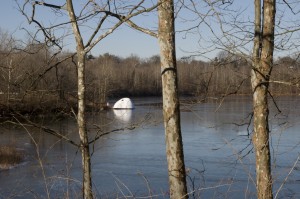
Andrea Zittel's island at 100 Acres. Photo: Indianapolis Museum of Art.
Richard McCoy: Will you describe where you were and what you were thinking about when you when you first thought of making a floating island for 100 Acres?
Andrea Zittel: I’ve been working on various ideas for habitable islands for over ten years, but it isn’t so often that you find an institution with a protected body of water willing to take on the challenge of maintaining a floating work of art. The idea of an island appeals to me as representation of many of the values that we strive for in our 21st-century culture: individualism, independence, autonomy, and self-sufficiency. Yet at the same time, these are the same desires that isolate us and lessen collective social and political power. I am fascinated at how the things that set us free are also the same things that oppress us; you could say that the concept of the deserted island is both our greatest fantasy and our greatest fear.
But regardless (and probably even because) of these complicated readings, I’m drawn to structures that generate a kind of personal autonomy for their inhabitants. In 1998, I made a very large habitable island in Scandinavia that eventually had to be destroyed because it was too large to be maintained. Fortunately, the project for 100 Acres is hopefully in for the long haul, and better yet, the Indianapolis Museum of Art (IMA) will allow a series of residents to live on the island over successive summers. The fact that the Indianapolis island will be a living and evolving project with multiple occupant/collaborators makes it particularly exciting.
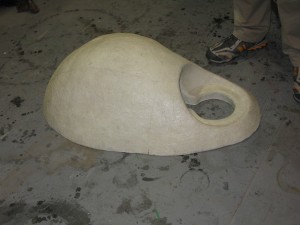
Small-scale model for Andrea Zittel's island at 100 Acres. Photo: Indianapolis Museum of Art.
RM: How did you first represent your ideas for this project (with drawings, sculpture forms, digital images)?
AZ: I had been working on a series of models for quite some time, so by the time that I received an invitation from the IMA, I knew exactly what I wanted it to look like. The next step was to make a working model for the fabricators, so I hired Steve Kim to make digital images of the island as well as a laser-cut model and scaled drawings that could be used by Smilee Barnacle (of the Los Angeles-based Barnacle Bros.) for the actual construction.
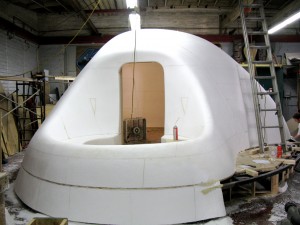
Andrea Zittel's island for 100 Acres being constructed at Barnacle Bros. Photo: Indianapolis Museum of Art.
RM: I recently read this quote on Robert Smithson’s webpage about “A Provisional Theory of Non-Sites”:
By drawing a diagram, a ground plan of a house, a street plan to the location of a site, or a topographic map, one draws a ‘logical two dimensional picture.’ A ‘logical picture’ differs from a natural or realistic picture in that it rarely looks like the thing it stands for. It is a two-dimensional analogy or metaphor — A is Z.
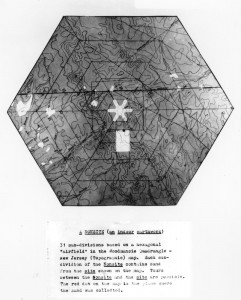
Robert Smithson, "The Non-Site" (an indoor earthwork), Photostat, 12 1/2" x 10 1/2", from www.robertsmithson.com
With this in mind, can you talk about how this has evolved from an idea or concept to what is now floating on the lake here in Indianapolis?
AZ: I interpret Smithson’s “logical picture” as one that refers to the relationships generated within the work rather than the external appearance of it. I would say that the island in its current condition (completed but uninhabited) is still only one element of the larger equation that will ultimately end up as the “work.” In this sense, it is still only a concept, but once the first inhabitant arrives and begins to add the accoutrements of his or her life, it will become activated into something that is more complete and multi-dimensional. At that time, it will make a far more interesting “logic picture.”
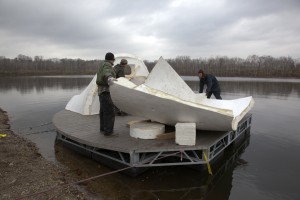
Barnacle Bros. assembling Andrea Zittel's island at 100 Acres. Photo: Indianapolis Museum of Art.
RM: Now that the island is in Indianapolis, is it reasonable for us to consider or imagine a new kind of “logic picture” for the island, one that provides a framework by which the project will live while it is here at the IMA?
AZ: If so, this framework would map a series of evolving relationships that take place over time but in a single space. The island, as we have built it, provides a framework that I feel a lone individual can easily work with. It is on the scale of a small room or large tent. There is an outdoor area with seating and a deck that connects to the water. The interior has a kitchen area, a spot for a portable toilet, and enough room for a bed and table and something to sit on, but the first inhabitant will have to map this area by building it out to satisfy their specific needs and not my projected ones. Then what the second inhabitant does to the residue of the first will be even more interesting. I’m curious to see how each resident works with both the framework that I’ve provided and the residue of what is left from former occupants.
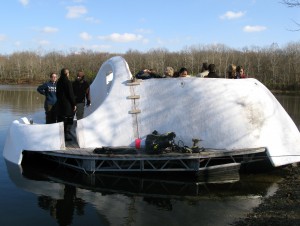
Andrea Zittel discusses her island with students from Herron School of Art & Design. Photo: Indianapolis Museum of Art.
RM: On the homepage of your website I encountered this statement:
The A-Z enterprise encompasses all aspects of day to day living. Home furniture, clothing, food all become the sites of investigation in an ongoing endeavor to better understand human nature and the social construction of needs.
I’ve had this statement in mind as I watched the crew from Barnacle Bros. construct the island. Will you distill the essence of the island that must be preserved in order for it to function on the terms of A-Z enterprises?
AZ: It should be a living, breathing, evolving work in order to retain the essence of my practice. It is important that there be unknowns, some collaborations, probably a few (hopefully reconciled) conflicts, and some very dimensional and unanticipated experiences connected to this work.
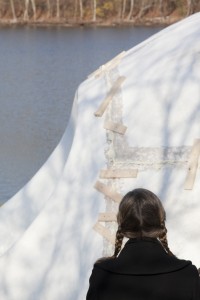
Andrea Zittel inspecting the assembly of her island at 100 Acres. Photo: Indianapolis Museum of Art.
RM: Conversely, how would it cease to function; what could make it fail to function as your work of art?
AZ: I think that the one way that it would fail is if it remains a proposal with no actual activation.
RM: The island seems to be responding to and creating a new aspect of the Indianapolis environment. However, the way this environment currently is set up within 100 Acres, it can only be activated by a resident living on the island. Can you talk about the environment or environments that this project encompasses?
AZ: I’m not quite sure if I understand this question exactly but I think that you are talking about an environment (my island) operating within the context of another environment (100 Acres)–and how these two work together.
Instead of describing physical properties, I would like to talk about the social relationship between the two environments. The island will be a highly personalized space within a public arena and in that regard, we have carefully thought about aspects of island living, such as access (the public won’t have access unless the resident invites them on board) and the resident, hired by the museum as a sort of “park ranger” who will spend time in the park talking to visitors and sharing his/her experiences with them. This isn’t a traditional way of making a sculpture public, but it is an interesting experiment that will draw upon the viewer’s capabilities for communication, projection, and fantasization.

Andrea Zittel's island at 100 Acres. Photo: Indianapolis Museum of Art.
RM: Do you have any guidance or suggestions for the Herron students who will be competing to live on the island?
AZ: I just hope that the Herron students can be as open as possible to the personal aspects of the experience and to try to use it as a means of experimentation and/or exploration, rather than feeling like it has to be an “exhibit” done solely for a public audience.
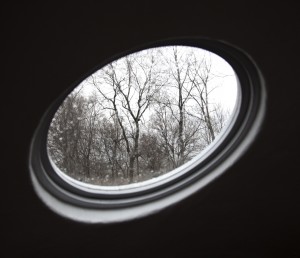
Looking through the window in Andrea Zittel's island at 100 Acres. Photo: Indianapolis Museum of Art.
RM: Do you have any guidance or suggestions for me as to the best way to care for your island?
AZ: Just treat it as you would a home. Respect the wear and tear that seems meaningful and try to preserve that, but clean and maintain parts of the island that begin to feel worn down or abused. (The differentiation is often an intuitive one, as discerning which is which can sometimes be a challenge!)
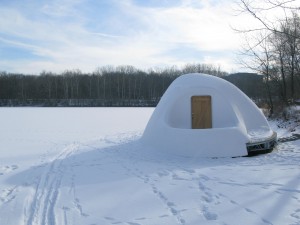
Andrea Zittel's island this winter at 100 Acres. Photo: Indianapolis Museum of Art.




Pingback: The Digest. 01.22.10. « C-MONSTER.net
Pingback: What’s Cookin at the Art21 Blog: A Weekly Index | Art21 Blog
Pingback: Flash Points: Art + the Environment Wrap-Up | Art21 Blog
Pingback: IUPUI Art Students to Inhabit Floating Fiberglass Island at new IMA Park | Asian Correspondent
Pingback: Looking Back Through 100 Acres | Art21 Blog
Pingback: Andrea Zittel… Fairly Fascinating Person of the Day « OMGBTW
Pingback: ANDREA ZITTEL | ciaocarla
Pingback: ‘Indy island’ – Andrea Zittel